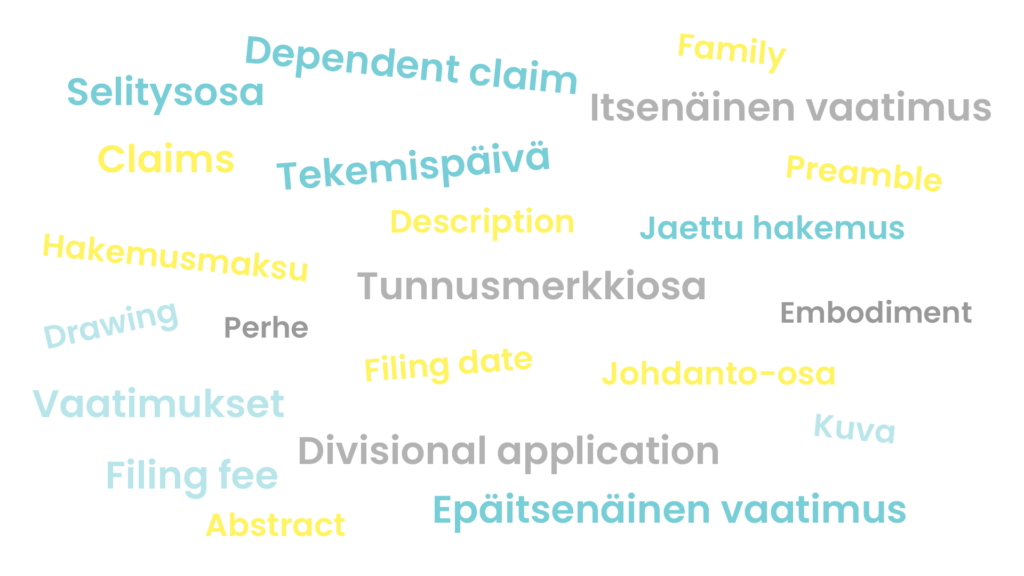IPR easily – Terms relating to application (part 4)

- Kaisa Suominen
- –

- Joose Kilpimaa
- –
- News
- –
- 13.4.2023

In the next part of the series IPR easily we will learn about terms relating to patent, trademark, design and utility model applications
Abstract
Patent applications must contain an abstract which briefly (typically with a maximum of 150 words) summarises the invention. In most jurisdictions the abstract is only for information, and its final content is determined by the examiner.
Characterising part
Claims should, when possible, be written in two parts, where the characterising part lists the novel and inventive features of the invention. The characterising part follows the terms “characterised in that”.
Claims
The scope of protection of patents and utility models is defined by the claims. The claims thus describe in technical terms the invention for which protection is applied for or obtained. Claims are thus the most important part of the application. They must be clear and concise, and a reader must understand the claims on their own, without reference to the description or the drawings. The claims may however comprise reference numbers used in the drawings, while the reference numbers do not affect the scope of protection.
Dependent claim
A claim that is in the same category (for example a device, a system, a method) than another claim, and comprises all its features. Often a dependent claim expressly refers to another claim with a number.
Divisional application
If an application contains more than one invention (from the filing or because the claims have been amended), the second or further inventions can be divided to their own application. A divisional application can only contain subject-matter present in the original (parent) application. It has the same effective date as the parent application.
Drawing
The scope of protection of a design application is defined by the drawings (or photos), and thus the drawings must be identical or very close to the product coming to the market. In some cases, the scope of protection of a trademark application is also defined by a drawing. Patent and utility model applications often have drawings which illustrate the invention and help understanding it. Such drawings do not need to be detailed and to the scale, they can be simplified.
Description
A patent and utility model application has, in addition to the claims defining protection, a description which describes the invention in more details. The description typically has a very brief introduction, a brief background part which discusses the prior art, and a description of the invention. The description of the invention often also includes different variants of features of the invention, also variants that are not in the claims. The description may also contain examples, especially in the field of chemistry.
Embodiment
An invention often has different embodiment, wherein the invention defined in the independent claim is the most narrow (i.e. it has the least features), and the other embodiments have additional features. Different embodiments are described in the claims and the description mainly in view of the situation where the original independent claim is not patentable, but needs to be narrowed by adding additional features therein.
Family
Applications in different countries relating to a same design, trademark or invention for a family. The family is based on a priority application, i.e. the family comprises all applications/registrations which have the same priority, as well as the priority application/registration.
Filing fee
An official fee which has to be paid for the application to remain pending. In some countries the filing fee must be paid to obtain the filing date. During prosecution, the applicant typically must also pay further official fees, at different stages of the prosecution.
Independent claim
A claim which does not refer to another claim and does not contain the subject-matter of another claim in the same category. Claim 1 is in practice always an independent claim, followed by dependent claims referring to it, and thereafter a possible second independent claim.
Preamble
In a two-part claim, the first part of the claim. The preamble contains those features of the invention which are known, and it ends with the terms “characterised in that”.
Trademark class
A registered trademark does not automatically provide protection for all existing goods and services. Goods and services for which trademark protection is sought have to be identified when filing the application. To make this more simple, a system for classification has been created. This system is applied almost everywhere in the world. The trademark classification system is based on 45 classes for different goods and services. Each class contain an alphabetical list of goods or services in that class. When filing a trademark application, the applicant adds those goods and services in the application for which protection is sought by using the classification system. The added goods and services will determine the final scope of protection of the trademark.
Find more abbreviations in the field of IPR here.


